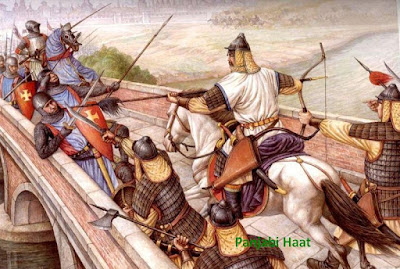Alexander's Invasion
In 321 BC Alexander
the great after breaking the might of the Persians entered their final
Satrapy of Punjab. He invited all the chieftains of this Satrapy to come
to him and submit to his authority, which is exactly what the ruler of
the northwest most (west of Hydaspes) kingdom of Gandhara with its
capital of Taxilai did. But the ruler of the Kingdom Between (Hydaspes
and Akesines) refused to submit to Alexander's authority and the two
armies fought the historical battle on the bank of Akesines outside the
town of Nikaia (somewhere around modern city of Jehlum).
Porus
put up a tough fight but his army was no match for Alexander's army.
After losing his sons and getting hurt himself when the defiant Raja was
brought in front of Alexander, the legendary conversation took place
when Alexander inquired Porus, ``How should I treat you?'', the brave
Porus shot back, ``The same way as a king treats another king.''.
Alexander was struck by his genius and he not only returned the Kingdom
back to Porus, but he also added the area lying between Akesines and
Hydraotis to his Kingdom whose ruler had fled.
Alexander
as with his other occupied areas established two cities in the area of
Punjab, where he settled people from his multi-national armies which
included a majority of Greeks and Macedonians. These cities along with
the rule of the Indo-Greek thrived long after Alexander's departure.
Alexander's
Eastern empire (from Syria to Punjab) was inherited by Selecus Nicator,
the founder of Seleucid dynasty. However the Greek empire in the east
was disrupted by the ascendancy of the Bacterians. The Bacterian King
Demetrius-I added Punjab to his Kingdom in the second century BC.
The
best known of the Indo-Greek kings was Menander who established his
independent kingdom centered at Taxila in 170 BC. He later moved his
capital to Sagala (modern Sialkot). Menander soon captured territories
east of his kingdom and grew to rival the power of Bacterians. Menander
died in a vain attempt to conquer Bacteria in 130 BC. Menander's
successors maintained the their rule on Punjab till 55 BC when the whole
area was disrupted by the events happening in greater Euro-Asia.
In
the middle of the second century BC, Yui Chi tribe of modern China
began to move westward which caused in turn to Sakas or Scythians to
move. Northern Sakas successfully wrestled the power of the areas from
the Indo-Greeks. Another Central Asiatic people to make Punjab their
home were the white Huns who made continuous campaigns towards this part
of the world. Finally establishing their rule in the later 3rd century
AD.
Muslim Invasions
Following the
birth of Islam in Arabia in 6th century AD, Arabs rose to power and
replaced the Persians as the major power in the area. In 711-13 AD Arabs
advanced to the land of five rivers, occupying Multan. Further north
the area that survived the Arab attacks was divided into small kingdoms.
Meanwhile
in Ghazni after the death of Subuktgin, the Turk, his son Mahmud
assumed power in 997 AD. He was to expand his father's kingdom far to
the west and east of Ghazni through his military conquest. He was to
attack Punjab 17 times during his reign.
The Ghaznavids were uprooted by
the Ghauris who extended their rule as far as Delhi. Shahabuddin Ghauri
annexed Lahore to his kingdom in 1186. After Ghauri's death his
governor Qut-bu-din Aibak became an independent ruler of Punjab and
founded the Mamluk sultanate. Khiljis' replaced the Mamluks in 1290.
The
rule of Khiljis was briefly disrupted by the two successful raids by
the Mongols who marched their way to Delhi twice during Alauddin
khilji's rule. Tughluqs succeeded Khiljis in 1320 AD. Tughluq rule was
replaced by the Sayyids in 1414 AD. Lodhis gained control of Delhi in
1479 AD.
to be continued...
Next: The Rise of sikh power.
Next: The Rise of sikh power.



No comments:
Post a Comment